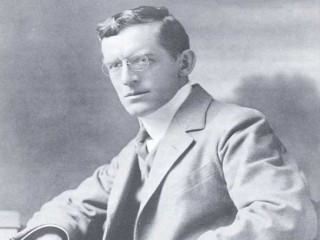
Ralph Adams Cram biography
Date of birth : 1863-12-16
Date of death : 1942-09-22
Birthplace : Hampton Falls, New Hampshire,U.S.
Nationality : American
Category : Arhitecture and Engineering
Last modified : 2012-01-20
Credited as : architect, Gothic style, Author
0 votes so far
Cram and business partner Charles Wentworth started business in Boston in April 1889 as Cram and Wentworth. They'd landed only four or five church commissions before they were joined by Bertram Goodhue in 1892 to form Cram, Wentworth and Goodhue. Goodhue brought an award-winning commission in Dallas (never built) and brilliant drafting skills to the Boston office.
Wentworth died in 1897 and the firm's name changed to Cram, Goodhue & Ferguson to include draftsman Frank Ferguson. Cram and Goodhue complemented each others' strengths at first but shifted into competition, sometimes submitting two differing proposals for the same commission. The firm's win of the 'United States Military Academy at West Point' project in 1902 was a major milestone in their career, and it meant the establishment of the firm's New York office, where Goodhue would preside, leaving Cram to operate in Boston.
Cram's acceptance of the Cathedral of St. John the Divine commission in 1911 (on Goodhue's perceived territory) heightened the tension between the two. Close attention can attribute most projects to one partner or the other, based on the visual and compositional style and the location. The Gothic Revival Saint Thomas Church was designed by them both in 1914 on Manhattan's Fifth Avenue in New York City. It is the last example of their collaboration, and the most integrated and strongest example of their work together.
Goodhue began his solo career on August 14, 1913. Cram and Ferguson continued with major church and college commissions through the 1930s. The successor firm is HDB/Cram and Ferguson of Boston.
A leading proponent of disciplined Gothic Revival architecture in general and Collegiate Gothic in particular, Cram is most closely associated with Princeton University, where he was awarded a Doctor of Letters and served as Supervising Architect from 1907 to 1929. For seven years he headed the Architectural Department at Massachusetts Institute of Technology.
Through the 1920s Cram was a public figure and frequently mentioned in the press. The New York Times called him "one of the most prominent Episcopalian laymen in the country". He made news with his defense of Al Smith, saying "I... express my disgust at the ignorance and superstition now rampant and in order that I may go on record as another of those who, though not Roman Catholics, are nevertheless Americans and are outraged by this recrudescence of blatant bigotry, operating through the most cowardly and contemptible methods."
As an author, lecturer, and architect, Cram propounded the view that the Renaissance had been, at least in part, an unfortunate detour for western culture. Cram argued that authentic development could come only by returning to Gothic sources for inspiration, as his "Collegiate Gothic" architecture did, with considerable success. He was not altogether inflexible on this point, however, rejecting Gothic for his Rice University buildings in favor of a medieval north Italian Romanesque style more in keeping with Houston's hot, humid climate. A modernist in many ways, to the chagrin of many traditionalists today, he designed Art Deco landmarks of great distinction, including the Federal Building skyscraper in Boston and a great number of churches in deco style. For example, his design of the tower of the East Liberty Church, Pittsburgh, was inspired by the Empire State Building. His work at Rice was as modernist as medieval in inspiration. His administration building there, his secular masterwork, has been compared by Shand-Tucci to Frank Lloyd Wright's work, particularly in the way its dramatic horizontality reflects the surrounding prairies.
In his review of the standard biography of Cram by Douglass Shand-Tucci, Yale professor and architectural historian Sandy Isenstadt writes: "what Shand-Tucci has done in this book...is to demonstrate how much (modernist) disdain (of Cram) turned out to be modernism's loss". Similarly, in another review by Peter Cormack, director of London's William Morris Gallery, the British scholar commented on the neglect of Cram's work, "a phenomenon which has significantly distorted the study of America's modern architectural history... (Cram) deserves the same kind of international--and domestic--recognition accorded (all too often uncritically) to his contemporary Frank Lloyd Wright".
















